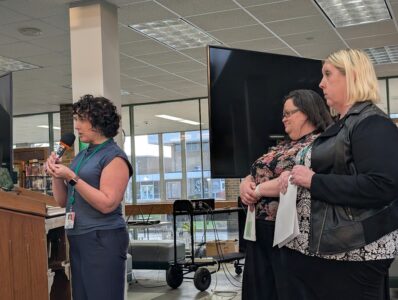Celebrating Alpena’s Catholic history
There is a fascinating history surrounding the four Catholic churches in Alpena. From their humble beginnings, to tragedy that forced them to be rebuilt, the steeples of the historic buildings have graced Alpena’s skyline for more than a century.
The Catholic churches have been a hot topic of conversation in Alpena for the last several weeks, as it was announced they would consolidate into one parish at St. Anne. This is a reversal from what took place in 1883 when Catholics at St. Bernard split the congregation along ethnic lines into three, and eventually four, separate parishes.
St. Bernard Catholic Church is the oldest parish of the four. It was established in 1864 by Bishop Frederick Baraga and officiated by Rev. P.B. Murray. It was the first Catholic church in northern Michigan.
The original church was constructed in 1880 across the street from where worship takes place today. Three years later the congregation, which was a mix of nationalities, split into three separate parishes, St. Anne, St. Mary and St. Bernard. The original St. Bernard became St. Anne for French-Canadian Catholics, the Polish Catholics formed St. Mary and purchased a Methodist church on Dock Street, now Second Avenue, and a new, stone church was built in 1884 for St. Bernard’s Irish congregation at its current site.
Alpena County Library Special Collections staff member Bob Lyngos said the churches were built large in order to accommodate the large congregations, many of which were from other nations.
“They were congregations of immigrant peoples and people still refer to the French church or the Polish church,” Lyngos said. “They were not only religious, but social organizations as well. Many spoke little or no English and the churches were a place they could feel comfortable.”
The churches have been built, rebuilt and repaired on many different occasions. The St. Anne church on Ninth Avenue caught fire on Aug. 4, 1907, and was rebuilt over the course of the next 13 years to the identical specifications and was completed in 1920. St. Mary also was consumed by a fire in 1888, as were 200 neighboring homes in the surrounding area. Most of the church records were lost in the fire.
The tall steeples that grace the churches also have been the target of lightening. St. Mary was struck in 1956 and damage was done to the belfry at the base of the steeple. Debris fell onto the sidewalk and there were two large holes in the top of the church that were repaired. In 1971 the steeple was removed and a new one installed.
Lyngos said the buildings of the time were always at risk of fire because even though they appeared to be built of stone, there were other materials that would be consumed by fire quickly.
“There were tremendous fires in Alpena that burned whole sections of the city,” Lyngos said. “You have to remember everything was wood in those days. Even the buildings that were brick were brick veneer over wood. The streets were made of sawdust, the sidewalks were wood, the furnaces were coal fueled and lights were from kerosene or gas, so there was a constant danger of fire.”
As the size of the congregations grew and members were inclined to have their children educated in a parochial school, the need for another Catholic church arose. St. John the Baptist Catholic Church was established in 1957 by Bishop Stephen Woznicki and a new church in the quickly developing western region of Alpena was built. Mass was held in the auditorium of Ella White School until the new church and an eight-room school was complete. The first mass at the new church was held in 1963 by Rev. John Kucinski.
Lyngos said churches hold a significant place in Alpena’s history and many are considered landmarks, as well as historical sites. He said they have and will continue to have a key role in the makeup of Alpena.
“I think they add a sense of stability and continuity in the community. People see these buildings and they are familiar to them,” Lyngos said. “Frankly I’m surprised by the number of old churches that were destroyed and new ones built. For me, at least, going into one of these old churches gives me a real sense of history.”
In May the congregations will become one again and St. Anne will be the prime location for Sunday mass. St. Mary, St. John and St. Bernard will be used for weddings, funerals and other religious functions as needed. As the needs of the Catholic church change maybe one day we’ll see these historical churches returned to their intended purpose.
Steve Schulwitz can be reached via email at sschulwitz@thealpenanews.com or by phone at 358-5689. Follow Steve on Twitter ss_alpenanews. Read his blog, Upon Further Review … at www.thealpenanews.com.






